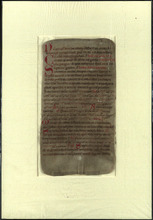Missal with neumes [leaf]
Tags:nLittera ScriptannNotes:n"...including music notation in neumes. nnProvenance:nThere is little doubt that the leaf has a Germanic origin and that it is mid-twelfth century in date. One feature of this leaf enables it to be more specifically attributed. This is the style of the ampersand and the letter 'g' which are exactly the same as on the leaf that was Lot 1 of the Korner sale at Sotheby's, 19th June 1990. That leaf was attributed to the workshop that supplied manuscripts for St. Peter's Abbey in Salzburg during the period 1147-1167. The scribe of this leaf may either have worked in this workshop, or very close to it. One noted authority has suggested the leaf may be of Austrian origin.nnVerso: n26 lines of text in Latin written in dark brown ink in one column on parchment. A fine mid-12th century proto-gothic script in two sizes, rubrics in red. The Verso is decorated with ten initials of various sizes in bright red. There are no signs at all that the leaf has been ruled. There is a sewn repair to the vellum in the inside margin that was made before the leaf was written on which the scribe has carefully avoided. 11 lines include music notation in St Gall neumes (see Notes). The responses, versicles and antiphons (in the smaller script) are setto music using neumes written without staves. Where words of the chant are split to relate to the melody of the neumes, the parts are connected by red lines.nnRecto:nAs Verso with a further six lines with music notation and four red initials. At the top of Recto is a folio number CCXXXIII in a 13th or 14th century hand.nnSource:nProbably Southern Germany, Salzburg, but possibly Austria (see Provenance).nThis leaf has presumably been used as a cover for a later pastedown. A fold can be seen down the outside edge and all four edges have been trimmed, presumably to remove unsightly damage. The parchment is browned and there is a degree of surface dirt but overall the leaf is in remarkably good condition for its extreme age.,Measurements (w/o matboards): 30.75 cm x 16.5 cmnMeasurements (w/ matboards): 49 cm x 33.5 cm,Full pdf available, https://dl.mospace.umsystem.edu/mu/islandora/object/mu%3A439223/datastream/PDF/view
